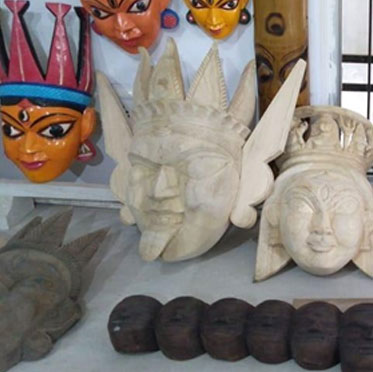





Nimmalakunta Leather Puppetry Craft
The Art of Leather puppetry craft is an ancient form of folk Arts in Andhra Pradesh, India. It was an Art of Livelihood in Ananthapuramu District of Andhra Pradesh, while Nimmalakunta, a remote village in Dharmavaram Mandal is famous for it. Many puppetry Artists from this village have shown extraordinary efforts in this Art. This art was famous by the name Tholu Bommalata which is best described as a composite art containing the fine arts of music, sculpture and painting.
The colours stand out beautifully and figures are magnified or shortened by varying the distance between the light and the puppets. The ancient form of this Art has been transformed into Craft Art by the way of interior designing and giving livelihood opportunities in the region.
At present, the items made through this craft are lamp shades, paintings, wall hangings, door hangings, partitions and modern puppets which are very popularly used in interior designing. Nearly 150 types of items are made in this village as household activity. Importance is being given to Indian epics like Ramayana, Mahabharata and Bhāgavata in preparation of models and puppets as well as modern designs as a background theme. These brilliantly crafted puppets were once the mainstay of riveting performances of episodes from the Indian epics. Western designs are also practiced by the village artists, keeping in view of the tourists who visit regularly to nearby pilgrim sites. View Vendor List...
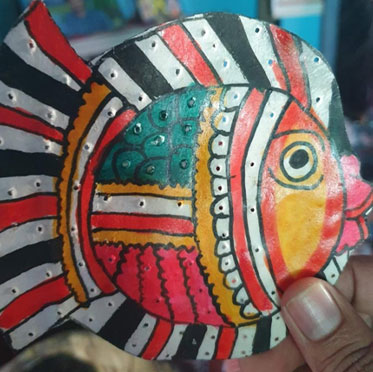

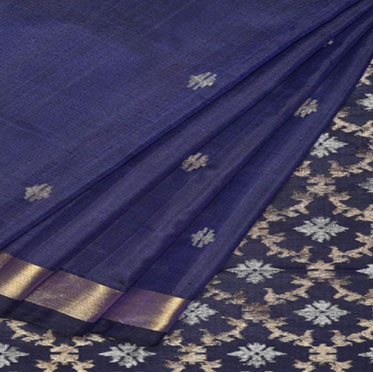
UPPADA JAMDANI SAREE
Uppada jamdani sarees are diaphanous silk sarees that trace its origin to Uppada village in Andhra Pradesh. Jamdani is handwoven fabric and is also known as muslin. The word roughly translates into flower vase (where jam means flower and dani means vase). The name has a Persian origin but the weaving technique of jamdani has Bengali roots. The Uppada form of jamdani has roots in east Godavari.
Historically speaking, jamdani as a technique was first written in Kautilya Arthshastra. The book dates to third century. This style of weaving was widely present in Bangladesh. At the time when the trade between the two places and their kings flourished, this weaving system also seeped down to east Godavari. Eventually, east Godavari villages started bulk production of Uppada. Artisans here generation after generation became quiet adept in this art.
Jamdani is created in remarkably interesting manner. Two weavers are required to sit in a pit loom. They work in tandem to make the fabric. The weft and warp threads are needed for the background are passed from one weaver to another and vice versa. The threads of designs that needed to be weaved in are added and embroidery is done. The design blends into the cloth with its margins are clearly visible and distinct and distinguishable on both sides. On the reverse side, there are no loose ends, threads or knots. At times, it takes months to prepare an Uppada saree of high design. View Vendor List...

Bobbili Veena
Musical instruments have been a part of our rich cultural heritage for a long time and India is known for its finest and rare traditions of music and exclusive part of inventing and making musical instruments. Veena is a very famous musical instrument used in various themes and classical themes. ‘Bobbili veena’ which is also known as ‘Saraswati veena’ or ‘Ekandi veena’ came in to existence in 19th century in response to challenge thrown at artisans of Vijayanagaram by Mussana chinnayya with respect to crafting quality Veena. Sarva Siddhi Acchanna with the permission of Zamindar and connoisseur Raju Ravu Venkata Krishna Rangarao prepared veena from Bobbili samastanam with different sound and structure.
Bobbili veenas are carved out of single peace of Jackfruit wood which is considered best for musical instruments. The Bobbili veena trough is roughly 14.5 inches and it has seven threats made of bell metal. Other veenas have threads made up of same number but are often made up of brass. The earlier patti veena 42 inches long one whereas this instrument is 54inches long.
As part of spreading cultural heritage miniature, Bobbili veenas have been presented to guests such as Mr Bill Clinton, the 42nd president of the United States. View Vendor List...
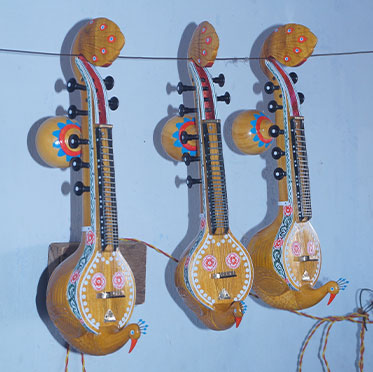

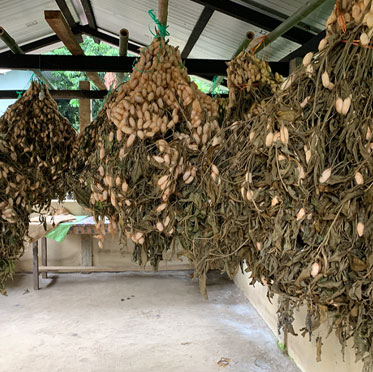
Muga Silk
Muga Silk is known for being one of the most expensive varieties of silk in the world. From silkworm rearing to the selection of cocoons and then to deflossing, reeling and weaving, the entire process adds to the uniqueness of the fabric making.
Antheraea Assama, the scientific name of the Muga Silk, itself points to the place of origin of this exotic silk. Assam accounts for more than 90% of the silk production. Muga production can be found in different parts of Assam, however, spanning from eastern boundary of Goalpara to the Kamrup region, we can see one of the hotspot of Muga production owing to the combination of factors like temperature, humidity, rainfall, soil and terrain.
Historically, evidence of Muga production has been mentioned in Kautilya’s Arthashastra (321B.C) and also some records say that rulers of Assam had gifted Muga silk to Harshavardhana, in around 7th century. With this delicate art of sericulture flourishing since ancient history, it was only under regime of Ahom kingdom that the sericulture production of Muga silk reached the zenith. Muga silk has carved place as a mark of royalty and provides a huge opportunity for employment growth as well as income generation. View Vendor List...

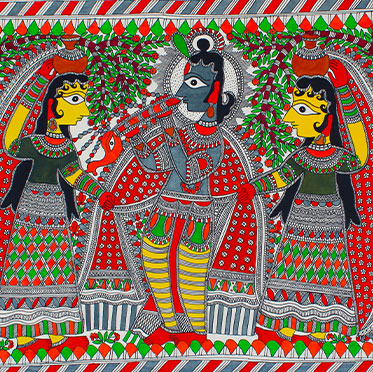
Madhubani Paintings
A 2500-year-old folk art, the history of Madhubani paintings is said to date back to the time of Ramayana, when King Janaka asked an artist to capture his daughter Sita’s wedding to prince Rama. These paintings were usually created by women on walls and floors of homes during festivals, ceremonies or special occasions. Having originated in the Mithila region, this form of painting is also known as Mithila art.
Though Mithila paintings are done by artists all over Mithilanchal and even in the far-off regions of Bihar, but villages in district Madhubani like Jitwarpur, Ranti, Raseedpur are more famous for being home to maximum number of world-famed Mithila Paintings artists. These paintings mainly depict mythological events which mainly revolve around the themes comprising of Hindu deities like Lord Krishna, Lord Rama, Lord Shiva, Goddess Durga, Goddess Lakshmi, Goddess Kali etc. It also depicts natural objects like fish, parrot, elephant, turtle, sun, moon, bamboo tree, lotus, tulsi plant and social events like weddings. Madhubani paintings are characterised by figures that have bulging fish-like eyes, pointed noses and prominently outlined.
In this painting natural color plays an important role. Artist makes colors from various natural elements. Black color is obtained from soot (kajal), yellow from turmeric (haldi), green from plant leaves etc. View Vendor List...

Surat Zari Works
A Zari is intricate metallic weaving (usually gold, silver, copper) done on cotton or silk textiles which gives it rich look. Along with traditional Zari Craft which is done using Gold or other pure metals such as Copper or Silver, imitation Zari work (done using plastics) is also on the rise now a days.
Though the earliest mention of metal work on clothing comes from Ramayana, Mahabharata, the direct origin of Surat Zari can be traced back to 14th century AD. Zari gained royal patronage during Mughal era. Surat became the hub of Zari, gold threads and textile exports. Due to both of above factors, people of various creeds and races began settling here and laid foundations of an Industrial/ commercial city. View Vendor List...
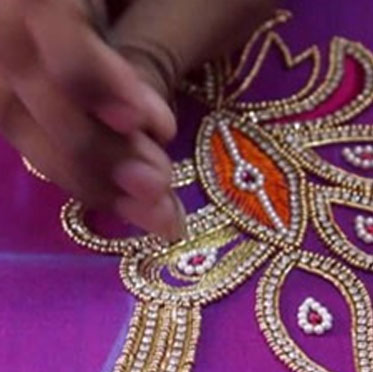

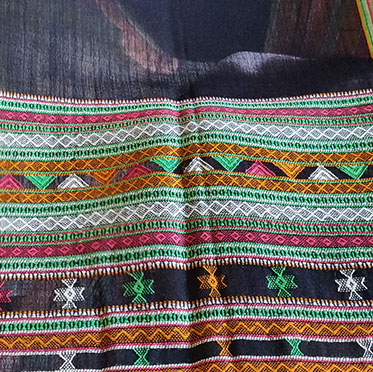
Kutch Shawls
The weavers of Kutch are originally from Rajasthan and there are different stories of their migration. They belong to Meghwal community of weavers from Marwar. The Marwada Meghwals developed weaving style with traditional motifs and colours in medium to heavy weight textiles. Now the weavers have created a weavers association to promote the Kutch shawls and have got platform to sell their produce through Rannotsav. View Vendor List...

Kutch Embroidery
The embroidery has its roots in the village economy. The women folk during their leisure time after harvesting got engaged in the needle craft and beautifully embroidered costumes for their daughter which later became part of dowry. All of the embroidered products were either for self-consumption or for decorative purposes or gifting to near and dear ones and were not for sale. There are more than 22 types of embroidery belonging to different communities with separate motifs, which have been clubbed up as Kutch embroidery. View Vendor List...
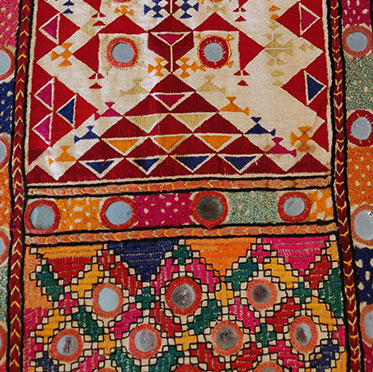

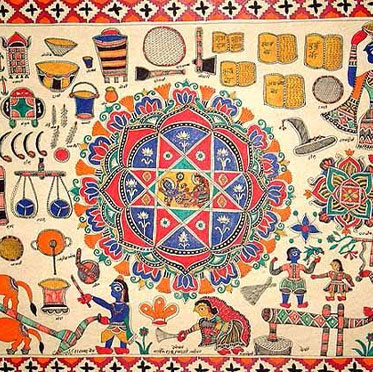
Sohrai Khovar Painting
Sohrai Khovar is a mural art painting which has been a tradition and ritual in Barkagaon block of Hazaribag district which is practiced by the local tribal women who have been using the local and indigenous material in the form of natural soils of various colors like black, yellow, red, white. Many prominent places like Birsa Munda Airport and also the railway stations in districts like Jamshedpur and Hazaribag have been decorated with these beautiful paintings.
The proprietors of the tribal of the block Barkagaon have been using the art primarily for self consumption and hence the art was not significantly remunerative. Occasions like marriages and harvest seasons were the trigger for the painting and hence the prime reason was the celebration. The proprietors were chiefly poor and depended on practices like agriculture, manual labor etc for day to day livelihood. View Vendor List...

CHENDAMANGLAM DHOTIES
Chendamangalam is a small town on the banks of river Periyar 30 km away from the main city of Ernakulam. It is a thriving centre of trade and exchange near the ancient seaport Muriris. This place is also known as the home for Malabari Jews although now the raw materials come from Surat, Gujarat but Chendamangalam weavers are famous for its on crafting and using their hadloom to generate beautiful mundus and dhotis. Weavers from Andhra and Tamil Nadu established the weaving centre here.
Padmashliyars chaliyars and bhattarayars are few of the weaving community practicing over generations.
Chendamangalam is famus for set mundus which became good source of employment after forming of cooperative Society in 1955 during the Travancore Cochin Societies act.
Cottom Brought from Gugarat is first Soaked into water to remove the impurities and chemical residue and then boiled for better finishing at 200ºC for 24 hours. Then they are washed ageain and oxidized to gain desired colours then left for drying for one day and three day in sunlight. After all these process, it is put on handloom mills.
Around 10,000 weavers, 4 to 5 thousands households and especially the population in gram Panchayat are part of this community. View Vendor List...
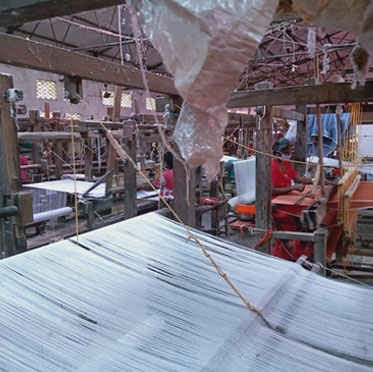

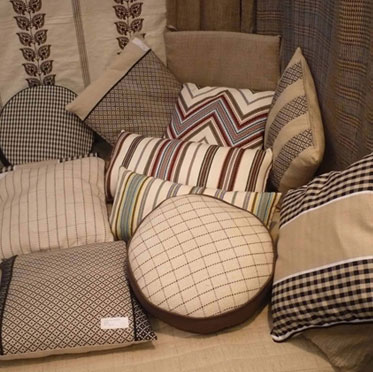
Cannanore Home Furnishings
Cannanore Home Furnishings refer to a set of items manufactured in Kannur district of Kerala. These items include textile home furnishing fabrics and made ups. Fabrics include Curtains, Table linens and upholstery fabrics, bed linen, kitchen linen, bath linen, lifestyle products like tassels, ropes, strings, nets, tents etc. The GI was registered on September 4, 2009.
Kannur has a centuries-old history of weaving. It is known as the Land of Looms and also as the Manchester of Kerala. Weaving in Kannur has been in vogue for about the past 400 years. In recent history, a small handloom factory was started in Kannur in 1852 and it was called the Basal Mission. Over the years, some of the handloom factories refashioned themselves into powerloom units while others remained as traditional handloom units.
From the 1960s, Cannanore Home Furnishings began to make its impact on the international market as well. Exports of these textile items began to take off and the producers also started adapting to the needs and tastes of their foreign clientele. This trend continues even now in Kannur.
The specialty of Cannanore Home Furnishings fabrics and Made ups are the compact structure and texture of cloth, unique colour combinations, wide width, skilled craftsmanship and colour fastness due to excellent dyeing quality. The land has very pure natural soft water source throughout the year, which is a boon for perfect dyeing of the first part of a very important process in Textiles. The products are distinctly recognizable due to the richness and the feel of life in it. With the traditional method by experienced hands, they can get any shade. The dyed colours can stand any international test requirements. View Vendor List...

Tikamgarh Bell Metal Works
The GI tag has been obtained by the single-casting bell metal artisans of Tikamgarh Town and Samarra Village of District-Tikamgarh (M.P.), for their traditional and indigenous bell metal products that have achieved national and international recognition and are highly valued.
The development of single casting bell metal work in Tikamgarh can be traced few centuries back to the creation of various types of ammunitions, arts and artefacts like Cannons, Idols and Toys made by the Swarnakars under the patronage of the Royal Maharajas of Tikamgarh.
With time, they began making bell metal artefacts for common populace like Pajebs, Kada ornaments; Bells for temples, cows and bullocks; Samai and Diyas; Gadiya Gulla for Sankranti festival; musical instruments - Manjiras, Jhanjar, Ghungroo; Palki handles; Chakki etc. Thus the bell metal artefacts became an integral part of daily life and the traditional festivity.
From economic perspective, the art is performed by the lower strata of Swarnakars. While the well-to-do Swarnakars did gold and silver-smith works, it was the lower strata Swarnakars who went on to take up the bell metal work. The same is still relevant. View Vendor List...
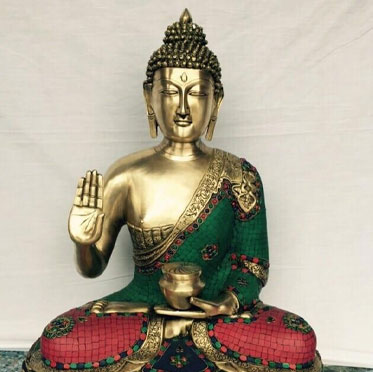

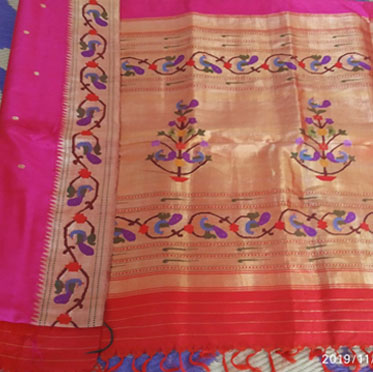
Paithani Saree & Fabrics
Paithani Sarees are made in the Paithan Taluka of Aurangabad. However their production is slowly shifting to Yeola Taluka of Nashik. Paithan Sarees are also known as Mahavastra since they are regarded as a must for all marriage ceremonies. Paithani Saree and Fabrics received the GI Tag on September 3, 2010. Historically, Paithan Taluka in specific is known for this uniqueness since the last 2000 years. During Satavahanas, Paithan was the centre for Zari and exporting centre of silk to Roman Empire. Satvahana ruler named Shalivahana promoted the growth of this craft. Later on Vakatakas, Rashtrakutas, Tughlaq, Mughals and Marathas all propagated Paithani Sarees and Fabrics. Paithani Sarees and Fabrics use zari are 100% handmade and can last for upto 100 years. The designs are inspired from Ajanta paintings and take months to complete. View Vendor List...

Karvathi Kati Tussar Silk Sarees
Karvathi Kati Tussar Silk Sarees are exclusively handwoven in the Vidarbha region of Maharashtra. Not just weaving the saree, but the entire cycle ranging from the cocoon breeding to cocoon processing to drawing out tussar threads, is carried out by the local population.
If the border of the saree is noticed, it has small temple like features (like the Vimana). This drives inspiration from the sculptures at the Ramtek Temple, few kilometres from Bhandara. This gives the saree a popular religious flavour too. They are not only worn at important household rituals or functions but also worn by the ‘Vidarbha Bride’.
Karvathi art is now being extended to cloth pieces, dress material, shirts and dupattas. Tussar silk is easily available in the jungles nearby as Vidarbha is a heavily forested region. This made the use of tussar silk traditional but nowadays, different materials like bamboo silk and mulberry are being used. View Vendor List...
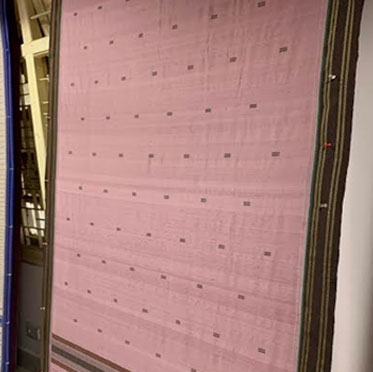

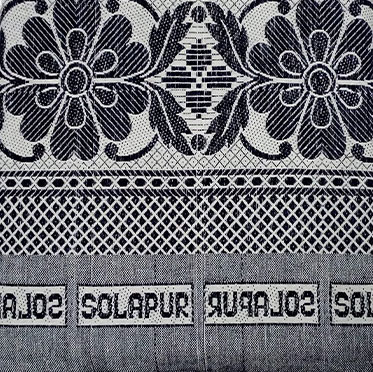
Solapur Chaddar
Solapur Chaddar, is a variety of bed sheet manufactured from cotton in the Solapur district of Maharashtra. Their unique designs and long term usability has made them quite popular across the country, and the Chaddar was the first product to be bestowed with the Geographical Indication status in the state of Maharashtra.
Known for its apparel and garment industry, Solapur once had some of the biggest spinning mills in Asia, and the weaving industry is said to have begun during the rule of the Peshwas. A large number of small weavers were a part of this industry, and the head of each artisan family handled the few looms that they had. Most businesses were family owned, and the women and children in the family helped the business in the initial processes or sometimes in the dyeing process as well. The advent of the powerlooms and the modern factories in the 1970s had a major impact on the local hand loom industry. The Solapur Chaddar was manufactured by the Padmashali weavers since the 1950s, and the demand for this variety has spread to states like Karnataka, Andhra Pradesh, Madhya Pradesh, Rajasthan as well as to countries like UAE, South Africa, Canada and United Kingdom. View Vendor List...

Solapur Terry Towel
Commonly called as the city of textiles, mainly due to its manufacturing capacity for producing terry towels, Chaddars and a variety of other products, Solapur in Maharashtra has truly developed into a major textile hub. The products like terry towels are manufactured by yarn or fabric dyeing and the looms are either rapier looms, hand looms or power looms. The Jacquard mechanism is applied for production of a variety of designs on the terry towels.
Direct employment is provided to nearly 1,00,000 people and nowadays power looms are mainly used for producing terry towels and other products. Around 3,000 powerlooms are being used in Solapur today and all the major textile products are manufactured on Jacquard type power looms. Nearly 80% of the textile production in Solapur is that of terry towels and napkins and Solapur enjoys a near monopoly like situation as it has a very high share of business in the global market for terry towels that have been made on jacquard power looms and are yarn dyed. Nearly 70% of the global demand for terry towels is fulfilled by the production from Solapur. View Vendor List...
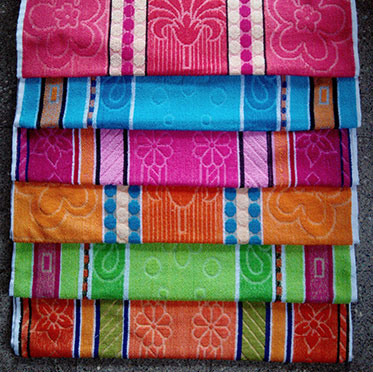

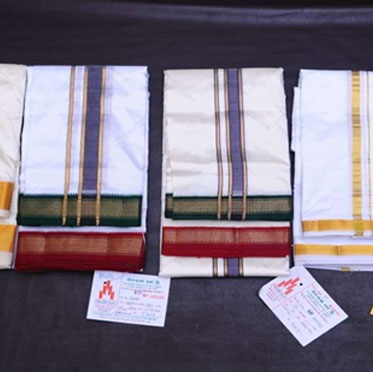
Salem Silk
The uniqueness of Salem Venpattu (White Silk) was recognized and granted GI Mark in 2008. Salem Venpattu Silk Dhotis are produced from time immemorial by the local traditional weaving community known as ‘Sourashtra’ Community. The silk dhotis of Salem are justly famed for their luster, whiteness, technical excellence and novelty of border designs viz., Nagachattai, Kammal, Diamond with Roja, Muthu with Gold Pettu etc. At the time of Manufacturing Salem Silk Dhotis are white in color. After washing they will be gradually changed to light sandal color and thereafter deep yellow color as it was in the beginning state of silk yarn before bleaching.
The chief attraction of the Salem Silk Dhoti is its luster. It is believed that the water used in the region is responsible for enhancing lusture to raw silk and may be one of the reasons for the whiteness and shining of silk dhoti. The jari in the border and pallu in the form of kambi is also unique.
White silk (Venpattu) dhotis woven from mulberry silk famous for its softness and lustre, whiteness, technical excellence and novelty of border designs etc. It is mainly hand-woven on pit loom/raised pit loom by the Saurashtra community in Salem district. Pure Zari/Half fine Zari (limitation Zari) is used in the borders of dhotis which is unique to this product. Border design in extra wrap is woven with the help of lattice dobby. Average weight of this dhoti is 250gm. These dhotis are mainly used in marriage like cultural and other traditional festivals. Also used as attires for Deities during Poojas. Other than dhotis, silk shirts and silk towel/scarves are also made using Salem Venpattu. View Vendor List...

PATHAMADAI MAT
Pathamadai pai (mat) is the GI registered product of Tirunelveli, Tamil Nadu. Pathamadai mat is famous worldwide for its unique features like softness, flexibility, health benefits like having cooling effect on the body etc. The mat is made from a local variety of grass called ‘Korai’ grass, which grows naturally in the banks of Tamirabarani River. The mat got GI registered in the year 2013.
The history of Pathamadai mat dates back to more than 200 years. The local Muslim community called Labbais is involved in this mat weaving for centuries. This being a handmade mat, most of them are hand-woven by women in the household. Initially the entire household was involved in the weaving process. Now, women are involved in manufacturing and men are involved in the marketing process. The mat plays an important role in the life of a Hindu. The mat is considered auspicious in most of the Hindu rituals like engagement, marriage etc. the mat has a worldwide reputation and was gifted to notable personalities like Queen Elizabeth.
There are around 300 families involved in the mat manufacturing. Most of them are home-based units. It takes around 15 days to complete a single mat. The cost of the mat varies depending on the size and design. View Vendor List...


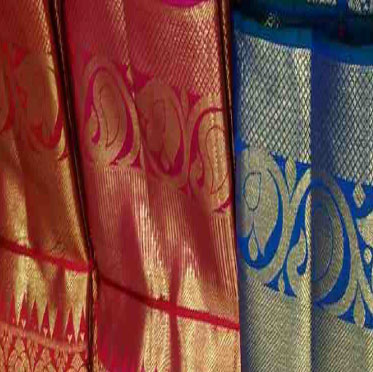
Arni Silk
In 15th century, the Vijaynagar empire got extended to North Arcot district under the rule of Kumarkampana. The introduction of rule of Vijaynagar empire saw massive changes in Language, dress and culture in this area. Vijaynagar kings started promoting small industries and one of such industry was silk saree production in Arni and Kancheepuram. Devikapuram & wadamadimangalam temple scriptures unearth this history of these Arni silk sarees. The quality of these silk sarges gradually improved in British time. In 2007 it was awarded the GI tag.
The designs are inspired by seasons and uses pure gold and silver Zari. There are 2 types of Arni Silk sarees namely Brocade which have intricate designs along with extra weft and Jangala type which have relatively soft fabric and come in fancy colours.
Arni silk is majorly produced in Arni town situated 60 km from the district headquarter at Tiruvannamalai. Now the production has also spread to nearby areas like Sevoor, Mullipattu, Munukupattu, Sirumani, Devikapuram and Irumbedu. Due to prevalence of Silk manufacturing handlooms it’s often called as Arni silk city. The area employs nearly 35000 artisans.The Arni Handloom Silk Park, is a project that has been envisaged in 2018 as a 20-25 acre facility which will be a one-stop facility to manufacture Arni silk sarees View Vendor List...

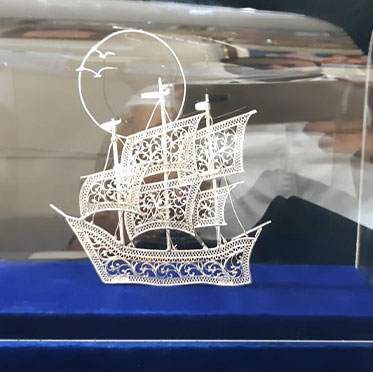
Silver Filigree
Filigree, earlier known as filigrann or filigrene, represents a delicate form of jewellery metalwork, and it is usually made of gold and silver. The pieces of work are accompanied by tiny beads or twisted threads, or both of these in combination. These are soldered together to the surface of a same metal object and arranged in the form of artistic motifs.
The roots of Filigree can also be traced back to the Italian and French metal work from 17th to 19th century. The English word filigree is derived from the Latin word "filum" which means thread and "granum" means grain that signifies a small bead.
Karimnagar region in Telangana is home to many highly skilled artists who practise the delicate craftsmanship called filigree. They are skilled in creating many articles through Silver Filigree such as Spoons, cigarette cases, buttons boxes, ashtrays, jewellery, buttons pill boxes, paandans and also perfume containers. They create special designs involving Peacock, parrots and fish which are clearly depicted in the perfume containers. The artisans of Karimnagar display fine mastery wherein they twist the delicate silver wire into delicate loops. These are knitted in a form of zigzag pattern which results in an intricate lace like appearance.
Filigree work, which is made using the twisted silver wire ushers a rare charm. The silversmiths crimp the thin strips of fine silver and create loops that are filled with designs formed by thicker and attractive silver strips. These strips and fine silver are further deftly soldered. The versatility of the art is not restricted or limited by tradition. View Vendor List...

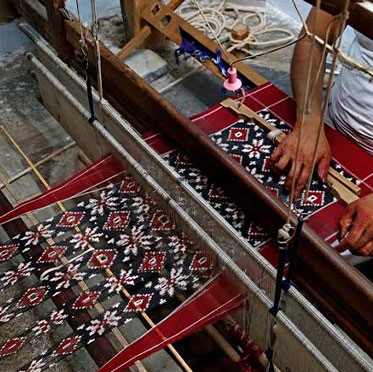
Telia Rumal
Telia rumal is the method of oil treatment on yarn. It is known for two-fold Ikat weaving with twist and weft structure using vegetable dyes. It originated in Chirala district of Andhra Pradesh. Now the skill is being taken forward by the weavers of Puttapaka village of Narayanpur mandal of Yadadri Bhongir district. Pulanpaka has more than 700 looms at the moment. Noted designer Gajam family has been making telia rumal for 75 years now. They have likewise have been granting the information on this unpredictable art to neighborhood weavers as well.
The previous designs of Telia Rumal used to be careful geometric or vegetal examples because of the inclination of the benefactors. However, after 1930s the specialists began fusing non-literal components like lions, elephants, flying creatures, tickers and even planes, which required better weaving aptitudes. It is no longer tissue size pieces that epicureans can purchase. The families associated with weaving presently make saris, dupattas, dress materials and other specially made pieces with similar strategies and intriguing examples. View Vendor List...

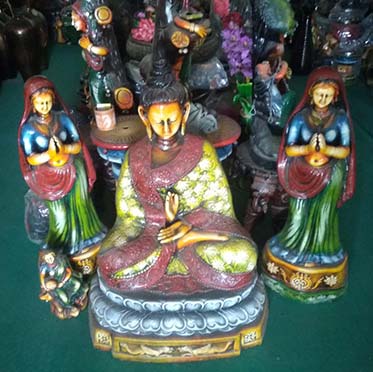
Gorakhpur Terracota
Gorakhpur Terracota is an age old craft of the Gorakhpur region and it is largely spread over the villages of Padri Bazar, Belwa Raipur,Jungle Ekla No-1, Jungle Ekla No-2 in Chargawan block and Aurangabad, Bharwalia, Langadi Gularia, Budhadih, Amawa, Ekla etc in Bhathat block of Gorakhpur. The art could not spread forward since it required clay of specific type which was found in the ponds present in these areas.
The craftsmen belong to ‘Prajapati’ caste, the Terracotta craft of Gorakhpur is an example of traditional art form thriving over generations. The craftsmen make various animal figures like, horses, elephants, camel, goat, ox etc with hand applied ornamentation. For this, refined clay is partially dried & cast, moulded or hand worked into desired shape. After drying it thoroughly, it is placed in a kiln & fired. Then the hot ware is covered with sand to cool. Some of the major products of craftsmanship include animal motifs like elephant Table, Hauda elephants, Mahawatdar horse, Deer, Camel etc. Further religious idols like Five-faced Ganesha, singled-faced Ganesha, ,Musical troupe of humans & Ganesha are also quite common. Other decorative items like camel cart, bullock-cart, horse-cart, camel-lamp, lantern, chandeliers, Hanging bells etc. are also popularly showcased. View Vendor List...

LUCKNOW CHIKAN CRAFT
Lucknow Chikan Craft is handiwork skill based craft. It is a type of embroidery on white fabric with white thread, with predominantly floral designs executed on fine cotton with untwisted threads of white cotton, rayon or silk. Chikankari is something like unity in diversity i.e. it includes some simple and complex stitches giving it an effect, which is simple, gentle and delicate.
The process of Chikankari undergoes five different stages, namely cutting, stitching, printing, embroidery, washing and finishing. The most common motif used is that of a creeper. Individual floral motifs may embellish the entire garment or just one corner. The different products manufactured by artisans include Caps, Chapkan, Angrakha, Kurta, Kurta-Kameez, Applique angrakha, Chikan T-shirt Kurta and Embroidered Sherwani. View Vendor List...
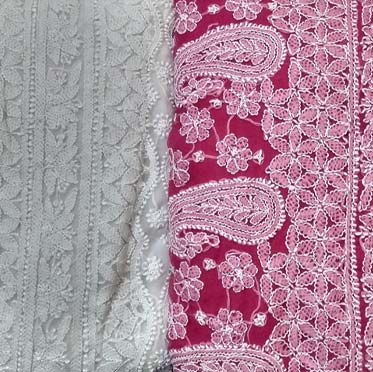

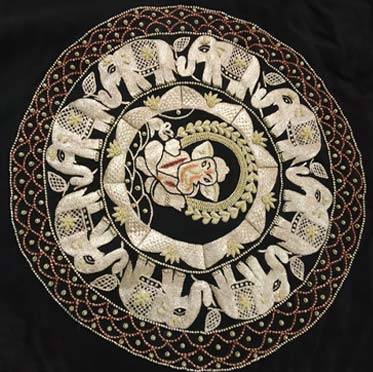
LUCKNOW ZARDOZI
Zardozi works are a range of embroidery products done by the devoted artisans.
Zardozi work has two distinct categories known as Karchobi and kamdani. The embroidery done on velvet or heavy satin generally for tent coverages, furnishings, etc. traditionally with badla was called Karchobi.
Kamdani generally refers to the work done on muslin, silk and other fabrics. The work here is done with great deal of minute skill in delicate rhythm. This technique remained more popular on the dresses, coverlets, caps and many miscellaneous items.
The process of zardozi revolves around five basic designs which have larger variation. These basic designs are jail (geometric design) (Line-drawings 56-70), bharat (filler design) (Line-drawings 71-76), patti (leaf), phul (flower), pankhi (bird), janwar (animal).
The Zardozi products incudes cane scabbards for swords and daggers, canopies, coats, caps, ghagras, covers for boxes, combs and mirrors, umbrellas, fans, shoes, bags, belt, saddle cloths, seat covers, carpets, bolsters, etc. and a variety of other objects. The artisans are also performing embroidery on saris, suits, dupatta, and lahenga, Jackets, shirts, long skirts, and longer scarves, etc. View Vendor List...

WOODEN HANDICRAFT OF SAHARANPUR
The history of wooden handicraft industry in Saharanpur dates back to 400 years back in Mughal era when some craftsman from Kashmir came back and settled in Saharanpur in search of bread and butter and eventually settled in the city to make the craft known worldwide as the Wooden Carving Industry of Saharanpur. With the seat of Mughal empire and the British in Delhi and the royalty associated with the classic wooden handicrafts, Saharanpur could develop itself as an industry overtime with generations of families becoming a part of this trade.
In 2014, the industry was given a GI tag. Initially, the industry was limited to household carving done on Sheesham wood which would be readily available in Saharanpur and the finished product would be supplied to markets of Delhi and Lucknow, but overtime with increased demand the use of wood like Mango and Keekar also grew with greater mechanisation. The products manufactured here still preserve with it the fragrance of years of heritage and history and the intricate handwork of the labourers. The products range from furniture, wall decors, wooden panels, antiques, gift items etc. In this endeavour of Atmanirbhar Bharat, the wooden handicraft of Saharanpur can serve as an important substitute to multiple imports and an attempt to regain the old glory of the city. View Vendor List...
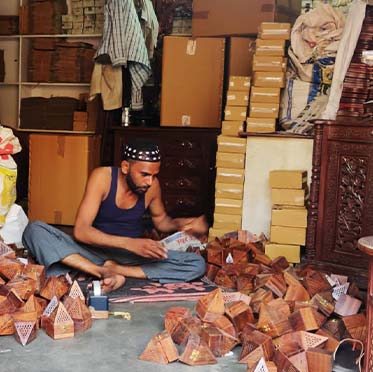

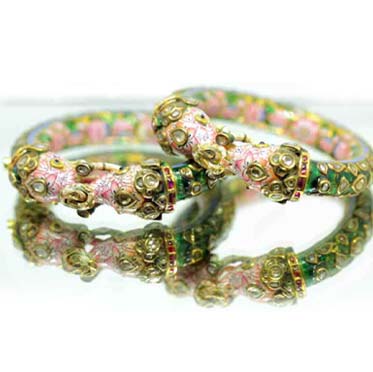
BANARAS GULABI MEENAKARI CRAFT
The pink enamel (Gulabi Meenakari) was brought to India by Persians in the 17th century during the Mughal period, attained its peak in Persian court during Qajar dynasty. The Banaras specialty is its Pink Meena on white enamel and often employs a lotus motif. Many people work on the product - goldsmith, ghaaria (engraver), the chitteria (designer), and jadiya who applies the gems on the gold.
Meenakari, also called enamelling, is the art of decorating a metal surface by fusing mineral substances on it. The process is often applied to kundan—articles of jewelry studded with gemstones set with a layer of gold foil between the stone and the mount on one side, while the reverse is lavishly enamelled using the meena technique. The luster of the meena increases over time due to contact with the wearer’s body and clothes.
The brilliance of the diamonds and other stones is effectively complemented by the multihued enamel of the meena. The present meenakars in Varanasi claimed that the position of the art of meenakari was prosperous till about hundred years ago. Now only a few artisans are involved in an otherwise flourishing industry of the past. View Vendor List...

CHUNAR BALUA PATTHAR
Chunar Balua Patthar is the second GI registered under natural goods category in the country. Bhartihari, the ruler of ancient Ujjain who came here for penance and built a grand fort here with Chunar Sand Stone, is a classic example of human skill with their uniqueness on the bank of holy river Ganga.
The National Emblem of India the "Ashoka Chakra" is taken from Ashoka Pillar of Sarnath which has made by Chunar Sand Stone is a unique example of their strength, quality and composition from beginning of 250 BC. View Vendor List...
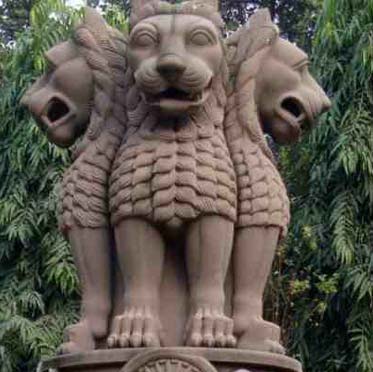

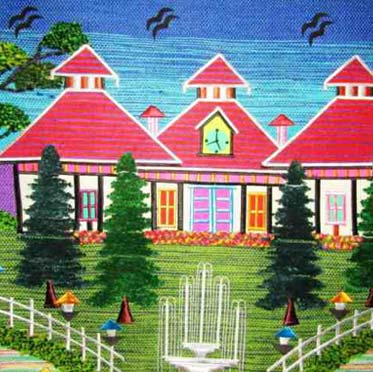
ghazipur wall hangings
Ghazipur wall hangings are interior decor items that are handcrafted in the small city of Ghazipur in Uttar Pradesh. These traditional handloom products are woven by skilled craftspeople with the help of simple sketch diagrams and involve techniques like: Hand-woven in pit loom (without Jacquard), Rapping with embroidery and Pasting work. They combine different yarns including jute and cotton, and use a blend of different colors to ensure not only strength but also an unusual unique texture.
The use of differing textures also forms part of the presentation of the patterning and design. These Ghazipur wall decorative hangings are woven on the handloom and their intricate patterning, colors and designs have wide appeal. A large range of designs bears testimony to the skill of the weavers, from representation of figures of Hindu gods and goddesses to intricate and detailed landscape arts with patterns of houses, lawns, forests, interiors, birds and animals.
The major production area is Devkali block and Saidpur of Ghazipur district and in Varanasi, Chandauli, Mirzapur districts of Uttar Pradesh.View Vendor List...

HANDMADE CARPET OF BHADOHI
This type of the hand-knotted carpet is manufactured on a vertical wooden loom by a unique weaving technique: with the use of knots, iron punja. Thick cotton and woolen yarns are used in the warp ends while wool is used in the width direction. These looms are equipped with a double layer of warp ends separator rods and platforms.
Designs depicting flowers, animals, gardens, trees and trellises are used in various hues and ways to liven up these floor coverings. The production process commences with the selection of woolen yarns which are generally bought from domestic and international circuits.
The wool used in carpets varies according to the quality, design and style and so do the colours. The original place of Bhadohi carpet has emerged from village Madho Singh Ghosia. View Vendor List...
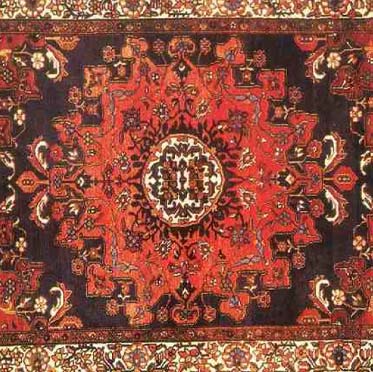

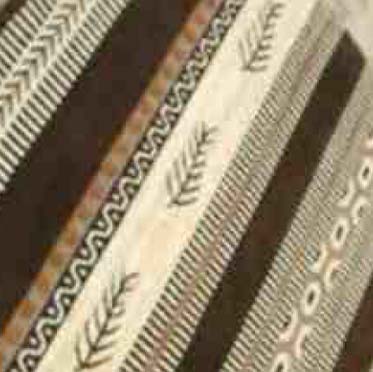
MIRZAPUR HAND MADE DURRIES
The Mirzapur Handmade Durrie is one among a multitude of styles of floor coverings. They are defined essentially by the use of the “Panja” for weaving, and are also known for their fairly bold colors and patterns.
Mirzapur Handmade Durries are woven in a weft faced plain weave on simple horizontal looms. Woolen yarns are mostly used; this gives them a sturdy and flat appearance. The mix of traditional and contemporary designs is evidence of a high degree of workmanship. The uniqueness of Mirzapur Handmade Durries lies in the fact that the whole process is entirely manual, starting from designing and weaving to finishing. View Vendor List...

VARANASI SOFT STONE JALI WORK
With the support of King of Varanasi, this Jali work craft emerged around the Ramnagar Fort area. Today the 4th generation craftsmen are working here. The artisans mostly belong to SC and OBC castes. They make them in accordance with their own perspective of history and mythology.
Jali or fretwork is intricately carved on soft stone (monolithic, and without any joints) and its process requires supreme mastery of masonry and design making. The Varanasi jali work epitomizes both high skill and superior quality of craftsmanship. Delicately chiseled and decorated with inlay work these elaborately carved jalis demand time in their making along with the skill and creativity.
The jali craft work can be seen on forts, zamindari homes, places of worship and ancient monuments all of which are a testimony of its antiquity. Statues of religious significance are also made using this technique. To further enhance the beauty of these sculptures they would be embedded with semi-precious stones and shell- work. Today small items of utility and decor are also produced such as table tops, boxes, coasters, trays, etc. The popular ‘Elephant within Elephant’ and other such pieces of Birds, animals, statues, etc are the result of the skills and sheer hard work of these craftsmen. View Vendor List...
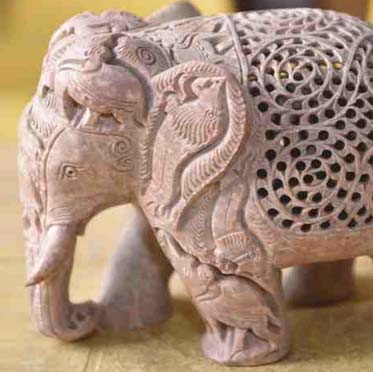

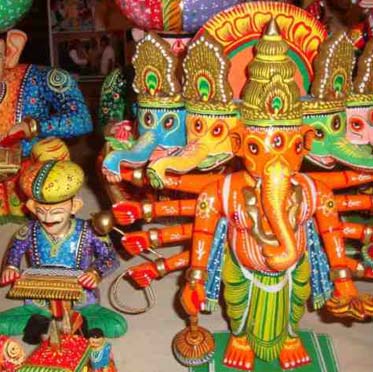
VARANASI WOODEN LACQUERWARE & TOYS
Varanasi and Mirzapur in Uttar Pradesh are famous for their wooden lacquer ware and wooden toys. The craftsmen here claim to belong to the Kunder Kharadi Samaj. It is an ancient craft and Varanasi has been a major center for the same. Sal or sheesham is the raw material used. Designs are created with the natural veins of the wood. These toys are made without any joints, and are attractive and safe playthings for children. The colours used are bright and primary. Kashmiri Ganj and Khojwa are the major centers of production. The toys have a ritual significance also and are not made just for play.
This craft plays a pivotal role in the lives of the artisans, since when a child is born a new lathe is added to the family possessions. In fact, when a marriage is being fixed the boy’s family makes sure that the bride-to-be is familiar with the lathe. Sets of birds, animals, musicians and dance ensembles are also available packed in boxes. View Vendor List...

BANARAS METAL REPOUSSE CRAFT
The craft is socio-culturally associated with the people of Banaras due to its generational legacy. It is now the 5th generation that is working in this area. In Varanasi, this art is mainly practiced by the Kasera Community in the Kaashipura area. The unique repoussé technique is sometimes referred to as ‘chasing’, or embossing (Khal - Ubhar Ka Kaam). The art has been preserved in the lanes (gali) of old Varanasi for generations, making various type of faces of God & Goddess, Gold and Silver dresses, traditional ornaments, doors and wall decoration in the temples, gold and silver utensils.
In the Mahakumbh Mela – Rath, Singhasan, Hauda, Chhatra, Chawar, Dand and other related products are available. Nearly 500 metal artisans are still working and few are much popular in the country for their exclusive work in the various important temples like Shree Kashi Vishwanath Temple, Golden Temple Amritsar, Tarn Taarn Gurudwara, Jain temple at Shravanbelgola, etc. View Vendor List...
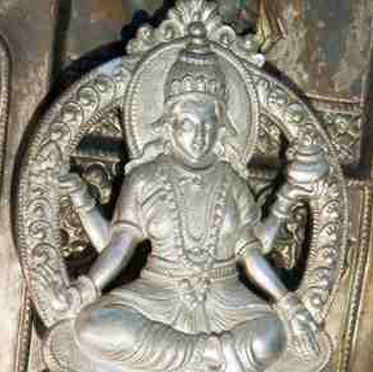

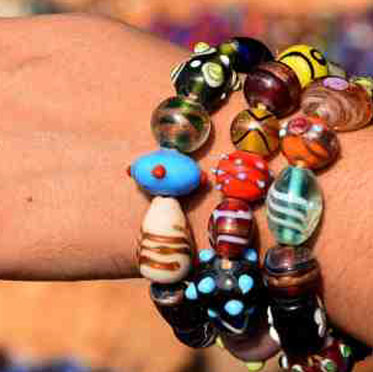
VARANASI GLASS BEADS
Varanasi is the oldest glass bead manufacturing Hub in modern India since 1940. It has the largest glass bead exports from India and has the biggest number of skilled artisans for the same. Archeological findings indicate that: 2000 yrs old glass making evidences have been found near Basti (UP) and that by 1000 BC glass bead making started in northern India. This craft is complete handicraft as it involves minimal intervention of tools. The craftsmanship has been passed mostly orally from one generation to the other (nearly 3 lakh design exist in Varanasi). Two type of producers exist here: small scale industries and artisans working from home with their own resources.
Different types of beads are used to ornament various products like clothing, decorative items, curtains, purses, clothing accessories, jewelry. More than 2,000 artisans are involved in bead production and handicrafts in Varanasi, with most of them being concentrated in the areas of Chandpur, Kandwan and Ramnagar. Major products include earrings, bracelets and neck pieces made out of multi colored glass beads. View Vendor List...

BANARAS BROCADES & SAREES
Banaras Brocades and Sarees are hand-made using finely woven silk, cotton and decorated with intricate designs using zari (gold and silver thread); this ornamentation is what makes the sarees heavy. Their special characteristics are Mughal-inspired designs/elements such as intricate floral and foliate motifs, such as kalga and bel. Other features are compact weaving, and figures with small details, metallic visual effects, ‘jali’ (a net-like pattern) and ‘meena’ work. Various types of sarees like Jamdani, Jangla, Jamwar, Tanchoi, Tissue, Cutwork, Butidaar, Sifon are traditional popular designs. Brocades like Kimkhab, Gyaser, Gyanta, Thanka, Pemachandi, Badalchandi are popular.
This art flourished during the Vedic times, reached its zenith during Mughal period and is mentioned in historical records like Jataka, Pali texts, texts by Patanjali and more recently District Gazetteers during British rule. Initially, Muslims practiced it but now both Hindus and Muslims are involved. The original Banaras weaving techniques is Kadhua weaving but due the demand of products now the Fekua weaving are used here with the support of Jacquard and Shuttle. In past, the whole technique was without Jacquard with support of Akra-Manda, Naka-jala-taka and this was the rarest handwoven method. Around 22 steps involving up to 17 people are used to make one finished product. Now a variety of stoles (dupatta) and other items are also made using this unique exotic method. View Vendor List...
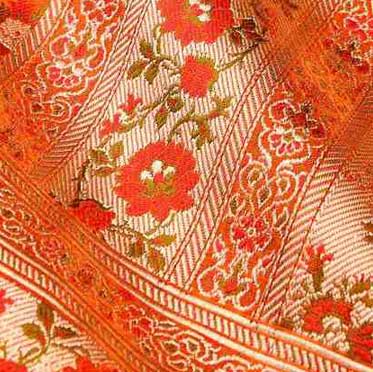

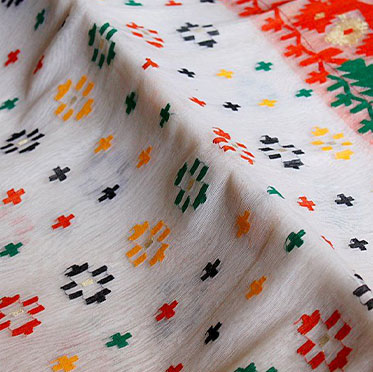
SANTIPURI SAREE
Santipur Saree is produced mainly at Santipur Municipality (Nadia) and its adjacent areas located at Nadia district. Having a recorded history from around 500 years, shantipur sarees are world famous and are woven across a variety of fabric like silk, tussar, cotton, mulmul etc. in roughly 1,25,000 handloom centers. Many varieties like Tangail, Shantipuri, and Jamdani saree are woven by the skilled artists. It got GI registered in 2009. View Vendor List...

MADHUR KATHI MATS
Paschim Medinipur district has a tradition of mat weaving known as Madhur Kathi. Mathur Kathi mats absorb sweat and do not emit heat, making them appropriate to the humid climate of the region.
There are three types of Madhur Kathi mats - ekhrokha, do rokha, and masland mats. EkhRokha are the simplest, light and thin mats while do rokha or double mats are thicker mats. Masland is of a higher quality having distinctive patterns, requires more than two people to weave it, and hence has the highest price amongst the three.
Madhur kathiinvolves weaving reed from madhurKottir (a sedge ofplant named Cyperus) and deriving maroon/red colours from seeds of Achiote tree (also known as Rang Gach in Paschim Medinipur), black dyes from Haritaki fruit and other colours from vegetable dyes. The dyed mats are then dried in sun before being used for weaving. Madhur Kathi was granted GI tag by Indian Patent Office in March 2018.
View Vendor List...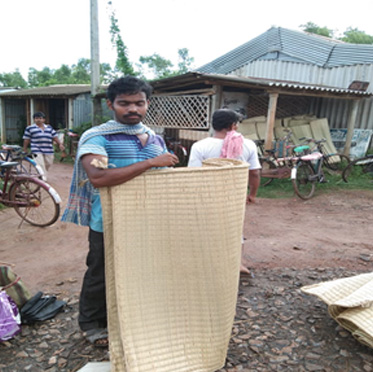

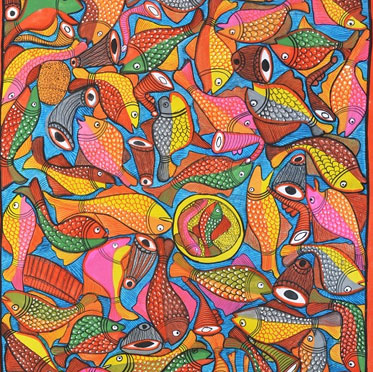
Bengal Patachitra
Bengal Patachitra is a traditional, cloth-based scroll painting mainly practiced by Painters called Chitrakars or Patuas in Naya village in the Pingla block of West Medinipur district of West Bengal.
The word ‘Pata’ comes from the Sanskrit word ‘Patta’, meaning cloth and ‘Chitra’ refers to painting. In Patachitra, stories are painted as frames on long scrolls and the Patuas who paint Patas, gradually unfurl them while presenting the story through their songs.
One of the fascinating aspects of Patachitra is the use of natural colours derived from local sources like fruits and flowers. The Patuas paint and sing on various themes like mythological tales (Ramayana, Mahabharata, Mangalkabya), historical and contemporary themes (biographies of great personalities, nuclear warfare) and social issues (women empowerment, child right, health, literacy). View Vendor List...

Wooden Mask or Mukha of Kushmandi
The Wooden Mask or Mukha of Kushmandi is an important part of theatre craft of Dakshin Dinajpur district in the state of West Bengal.
The masks are usually adorned by the Rajbanshis community during the monsoons, especially during the cultivation season. This is an ethnic group found in North Bengal and nearby areas. Rajbanshi means royal community and they have their own specific cultural practices. There is a ritualistic dance form called Gomira dance which is done in adoration of the Gods to usher good fortune and drive out evil forces.
There is another type of Mask that is used in household for the decoration purpose. The two types of masks are made by the same process and materials, with some difference between them. If the mask is to be used for the purpose of dancing, only then the eyes, mouth, etc are hollowed out. The masks that are crafted for decoration purposes are also bulkier and heavier than the mask used in Gomira dance. Recently the artists are making diversified products in the form of small fridge magnets, lamp shades etc.
Kushmandi’s Wooden Mask got the GI status through the application made by Mahisbathan Hastashilpa Samabay Samiti Limited in 2018. Approximately, one thousand artisans are involved in carving of wooden mask. View Vendor List...
